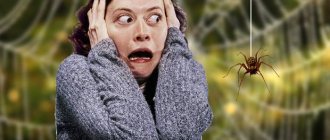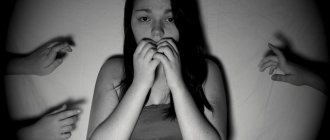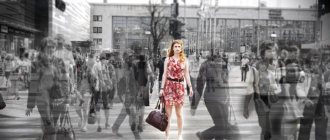Slava Profina 07/25/2018
5
It is common for every person to be afraid of something. A phobia is a term used to describe negative experiences associated with a threat to the physical or emotional functioning of an individual. If fears, as a rule, arise as a result of real danger, then phobias are sources of imaginary danger. One of these phobias is anthropophobia, which is the name given to the fear of people.
Identification of anthropophobia
Does it really matter what others think? A sufficiently developed individual would not judge a stranger by one look or action, because their perception speaks volumes about their qualities. If the stranger was smart, his gaze would not be angry or judgmental. After all, intelligence allows you to understand that negativity towards others will aggravate the situation. How to get rid of the fear of people who look judgmentally and why do they look like that? Rather, negativity and fear accumulate in their lifestyle. Most modern people constantly compare themselves with others, and finding a negative character trait in a stranger means being better than him. Being the best brings them joy and peace. This is how people live lives that are not their own, achieving success in areas that are not interesting and constantly experiencing a feeling of emptiness. In society they can be significant individuals. By drowning out the feeling of emptiness, people usually sublimate fear:
- Acquire property.
- They judge others.
- Host or take excessive part in parties and social events.
By doubting your worldview and observing yourself, you will find the way you like yourself, which brings sincere joy, since overcoming fear of people means not living as before. There is an assumption by psychologists that personality is lost in the crowd. If getting together with friends every weekend and drinking alcohol for several years is the norm, then after several years of such friendship, if one of them refuses to spend time with alcohol, conflict is likely to occur. If a person is psychologically weak, he will start drinking again, for fear of losing “human friendship.” There are also global urban personalities who are constantly afraid of how they look in public places and whether their gait looks awkward from the outside. Such thoughts and then fear arise from self-centeredness. Try to transfer your thinking model to every passerby and imagine that everyone thinks this way. You will understand that in fact, fear of people is illusory, and everyone thinks about themselves, and not about you. This is confirmed by the words of Dale Carnegie: “a person is more worried about his own headache than the death of someone else.”
Reviews of the work of psychologist, hypnotherapist Gennady Ivanov
The mechanism of formation of phobias is based on the idea of the dual nature of the psyche, consisting of consciousness and subconsciousness. We will use the term “subconscious”, thereby emphasizing that this “internal knowledge” can be realized. The real problem is the irrational part of fear, which over time develops into a phobia - an inadequate reaction to the environment. The rational component of fear must remain, because this basic emotion mobilizes the body’s strength in order to survive.
Treatment of phobias comes down to a conscious search for an associative connection of a particular symptom with a traumatic event of the past. Hypnotherapy techniques erase and “demagnetize” a conditioned reflex, which in many cases acts as a hypnotic suggestion.
❂ Hypnosis: review of the treatment of fear of riding the subway & psoriasis.❂ Doping news. How and why is hypnosis effective in sports? ❂ Hypnosis: review of the treatment of dog phobia (kinophobia).❂ Hypnosis: review of hypnosis treatment of skin diseases (lichen erythematosus). ❂ Hypnosis: review of the treatment of fear of the dark (nyctophobia). ❂ Psychosomatics & Hypnosis: review of the treatment of panic attacks. ❂ Why hypnosis is effective in working with memory ❂ Hypnosis: review of the treatment of arachnophobia (fear of spiders). ❂ Hypnosis: review of the treatment of tachophobia (fear of speed). ❂ Hypnosis: a review of the treatment of fear of public speaking. ❂ Hypnosis: review of the treatment of ophidiophobia (fear of snakes). ❂ Hypnosis: review of the treatment of social phobia (prohibition of expressing emotions). ❂ Hypnosis: review of the treatment of social phobia and acrophobia (fear of heights). ❂ Hypnosis: a review of the treatment of social phobia (fear of judgement).❂ Tattoo under hypnosis. Self-hypnosis training.❂ Hypnoanesthesia. Treatment of deep caries under hypnosis.
Article rating:
(
1 ratings, average: 5.00 out of 5)
Share with friends:
Anthropophobia as part of social phobia
Taken together, these situations are united by one ailment - dependence on the opinion of society. This means that the question of what the fear of people is called can be answered in two ways, since anthropophobia is a type of social neurosis that manifests itself in:
- desire to avoid society;
- fear of strangers;
- psychological discomfort due to violation of personal space.
Anthropophobia is a more “narrow” fear, aggravated under certain circumstances, which can exist separately or progress, merging into social phobia. The difference between anthropophobia and social phobia is the fear of an individual stranger. Social phobia is characterized by a fear of large crowds of people.
Most people have some degree of social anxiety. Anxiety disorders come in different forms and degrees, ranging from mild sensitivity, which occurs in many people, to fear of new acquaintances, when putting oneself down and placing someone on a pedestal. A more severe form is a disorder that reaches its peak when anthropophobia forces one to stay at home, while experiencing fear of leaving the apartment. Even shopping becomes a painful process. Those who feel afraid of people and are prone to social anxiety of any form are people who exaggerate the importance of public opinion and other people.
Salar de Yuni
What is a phobia
Fear of crowds - what is this phobia called and how does it manifest itself?
Anthropophobia is the fear of large companies and individual people, regardless of their age, gender and appearance. It often develops in adolescence, can progress into adulthood, and is equally common in women and men. The feeling of fear arises randomly and suddenly, sometimes in the form of a reaction to certain types of people.
Often anthropophobia occurs as a result of a psychoneurotic disorder, fear of shame and disgrace - scoptophobia. When joining a team, a person fears that his actions will be condemned by new people. Fear of all strangers can progress from a phobia to a disease and become the cause of neurosis.
Development of social phobia
The history of social phobia begins in the 60s of the 20th century, when psychotherapists became interested in phobia. The teaching was carried out using the method of psychoanalysis of Sigmund Freud. The theory that childhood plays a crucial role in the formation of personality, and most fears are formed from an early age, has been the main guide to the understanding and treatment of mental disorders.
Caring deficit
Anthropophobia develops against the background of emotional closeness between parent and child. Thanks to care and affection, the child feels needed. With a lack of care, the baby feels useless and grows capricious and irritable. A child experiences stress when attending kindergarten. Fear grows due to the emotional lack of parents. There is a fear of people, of the unknown, which provokes the development of future anthropophobia.
For the benefit of society
Those of us who were raised in a society where the opinions of others were important also acquire fear of people as a mental illness. The Soviet space is a vivid example of where dependence on the opinions of others was in the first place, where there was a fear of appearing wrong and standing out as not desired by society. This is how parents, out of their own fear, raised their children, constantly reprimanding and uttering phrases: “what will people think of you,” “look at yourself, who you look like,” and the like. With such an assessment, the child lives with a feeling of unworthy behavior. Comparing a child with someone else unfavorably also leads to the feeling that others are better.
White crow
In society there is a concept of “black sheep”; they point fingers at such people, mock them, and don’t want to be friends. Under general pressure, fear is established and the process of incorrect self-determination begins; we become confident that we are strange, incorrect, and not like everyone else. An aggressive family environment greatly increases the risk of children acquiring a fear of communicating with people. Words spoken in the heat of the moment to a child between 1 and 8 years old can hurt and bring distorted confidence, so you should be careful what and how to say. Painfully shy children, especially in front of guests, should not be shamed for being taciturn or impolite. The reason for shyness lies in a defense mechanism that occurs as a reaction to excitement or fear. Sometimes the phenomenon of selective muteness appears as a result of paralysis of the speech organs at the physiological level.
It happens that anthropophobia and fear appear later, for example, when changing place of residence. Coming to a country without knowing the language, you can feel insufficient and unworthy. Against this background, a fear of people and new contacts develops. But such fear can leave its shell if this is not a clinical case. Understanding your own projection of self-rejection and personal illusion will help you get rid of fear.
Put on a pedestal
In psychology, there is a concept of the feeling “I am not okay - others are okay.” A person who grew up with this feeling then experiences fear of communicating with people unfamiliar to him, especially if the stranger is higher in status or material level. It is no longer a question of communicating on equal terms with superiors or wealthy people. What happens here is that one is placed on a pedestal based on subjective opinion.
The phenomenon is common in Japan. This type of anthropophobic people is called “hikikomori”. The word means “to hide, take cover” in Japanese. Young people do not leave their homes for years and often live with their parents. There are about 1.5 million people and the number is increasing over the years.
One of the reasons for such a phenomenon as anthropophobia is the inflated demands and expectations of society. If previously a child just needed to be born, get on his feet, and learn to help with housework, today children from early childhood are required to attend courses, engage in self-improvement, learn to behave and act in a certain way. The framework becomes so rigid that the child constantly lives with the feeling and fear that he can’t do anything, doesn’t measure up, and society, like an all-seeing eye, always evaluates.
Where does the fear of people come from?
It is assumed that social phobia is formed as a result of the interaction of hereditary and social factors.
It has been established that immediate relatives of social phobics also suffer from this disease or another anxiety disorder. Children are capable of adopting destructive forms of behavior from adults and internalizing destructive patterns in the subconscious.
Social phobia appears in childhood under the influence of a pathological model of upbringing.
- overprotection;
- emotional coldness towards the child;
- excessive demands;
- excessive severity.
Pathological forms of upbringing provoke the formation of unwanted stereotypical statements about oneself: I am not good for anything, a useless person.
A special role in the manifestation of the disorder is given to psychotraumatic situations in childhood and adolescence, when the child experiences shame or another negative emotion. In childhood, we cannot correctly assess the state of things, and the incorrect interpretation of events gets stuck in the subconscious. Subsequently, under “successful” circumstances, she will manifest herself with an attack of panic, shame and awkwardness. Such a reaction becomes a defense mechanism, like the instinct of self-preservation when confronted with society.
A parallel is also drawn between the onset of the disease and relationships among peers. It was noticed that teenagers who were not popular among their peers were more likely to develop social phobia. Children were bullied. They endured moral and physical violence.
A 40-year-old man suffers from panic attacks. The first attack of PA occurred at the age of 20, and since then has accompanied the patient constantly. The attacks especially intensified at the time of public speaking: when reading a report to the work team. The man felt dizzy, a feeling of heat followed by chills. It seemed like the end of the world was coming. Fear of speaking in front of employees prevented the patient from moving up the career ladder.
There was an incident in 4th grade. The teacher called the boy to the board, asking him to repeat the tongue twister. The remark turned out to be filled with the sound [r], which the boy pronounced with a frank burr. The tongue twister turned out to be difficult to understand. The class laughed at the “announcer” for a long time and subsequently teased him. After this episode, the guy was afraid to go to school and was embarrassed to answer near the blackboard.
Relationships with classmates were difficult. The man's mother suffered from depression. My brother also had panic attacks.
The man addressed his problem to the doctor. Based on complaints and medical history, he was diagnosed with social phobia.
It happens that social phobia develops not only after one’s own negative experience. The disorder can manifest itself in a witness to an unpleasant situation.
Biological factors occupy their niche in the occurrence of the disorder. In patients with social phobia, changes in the level of neurotransmitters in the brain were detected. Increased sensitivity of the amygdala, a brain structure responsible for emotions, especially the controlling feeling of fear, has been recorded.
Signs
If you suspect or have discovered that you have a fear of people, these signs will help determine whether a phobia exists:
- The feeling of being watched from the outside.
- Fear of embarrassment and disappointing people.
- Conscious exclusion from society, seclusion.
- Fear of communicating with people, getting to know each other.
- Expecting a moral blow, looking for negative qualities in the environment.
- Fear of public places, crowds of people.
- Fear of physical contact with strangers, for personal space.
- Fear of a certain category of people (overweight, drunk, elderly).
Anthropophobia is expressed by a specific clinical picture, which involves cognitive and autonomic disorders. Cognitive manifestations include an inexplicable, persistent fear of the thought of speaking, touching a person, going out to people, or meeting a dangerous person. Autonomic symptoms of fear make themselves felt:
- tremor of the limbs;
- attack of suffocation;
- rapid heartbeat;
- numbness;
- redness or pallor of the face, spots on the chest;
- sudden sweating;
- vomiting, diarrhea.
When panic attacks occur in anthropophobes, there is a need for compulsions - obsessive motor acts that have a protective meaning and are of the same type. Often compulsions are associated with cleaning (washing hands, cleaning, wiping surfaces, dishes).
Fear of people, as a rule, has a high level of comorbidity, that is, it is combined with other disorders or diseases, such as depression, alcoholism, and drug addiction. Fear of communication is associated with autism.
Professional treatment
How to treat anthropophobia depends on the severity of the disorder. As a rule, with such a disorder, an integrated approach is practiced - drug treatment, psychocorrection, getting rid of complexes, group psychotherapy.
Treatment begins with taking medications. The doctor may prescribe tranquilizers or sedatives, depending on the state of the patient's nervous system. The drugs reduce mental stress and help control your own emotions.
The next stage is individual psychotherapy sessions aimed at changing a person’s thinking so that he can get rid of his own complexes and self-doubt.
The best way to overcome anthropophobia is group psychotherapy. This allows you to face fear face to face, as sessions take place in groups.
Help yourself
Social fears are illusory. If there is a slight fear of people, the essence of getting rid of the problem lies in meeting the fear halfway. The methodology includes a number of recommendations:
- To eradicate the fear of crowds, you need to overcome fear and take the opposite action of fear.
- Work with your thoughts and inner state. Look at things positively. Start thinking good about yourself.
- Stop living in the past and blaming everyone around you for your own problem. Many people think that everyone owes you, for example, all girls are materialistic or any boss is a tyrant. Until you go out to people and start communicating, fear will not disappear.
- Take up a new sport. This will help not only stand up for yourself, become more attractive and healthy, but also defend your point of view.
- Remember, even if you did something ridiculous, stupid, they will soon forget about it.
- Allow yourself to be anyone, boring, sad, in a bad or good mood.
The recommendations are useful for both anthropophobic men and girls. Women, due to their emotionality and openness to admitting a problem in themselves, are more likely to seek professional help.
Fear of looking people in the eyes: how to get rid of it?
Fear of looking people in the eyes
Although this type of phobia causes minimal discomfort, it is still necessary to fight it. After all, if you do not look your interlocutor directly in the eyes, he may think that you simply do not want to conduct a dialogue with him.
Advice from psychologists:
- Exercise regularly. To do this, stand in front of the mirror several times a day and try to look at your reflection for as long as possible.
- Give yourself the right attitude. You must realize that a person’s look, even dissatisfied, will not particularly harm you.
- When communicating with someone you don’t know well, try to control your breathing and at the initial stage you can temporarily shift your gaze to the bridge of your nose.
- When walking down the street, never take your eyes off passers-by, especially if they were the first to start looking at you. This way you will train your tenacity of gaze.
- Train your peripheral vision. This will help you remain calm at all times, and you will be able to look into the eyes of your interlocutor for as long as possible.
Therapy
If the patient does not leave the house for years, and small activities that require contact with people become impossible, such anthropophobia takes on severe forms. Severe fears are treated with medication with the addition of psychotherapy. The psychiatrist prescribes maintenance medications to calm the patient and develop an impulse for action. At the same time, the cognitive-behavioral approach plays a leading role. Social skills are practiced along with relaxation skills. At this stage of treatment, the patient’s goals are prescribed, and each step towards achieving the goal is worked out step by step under the supervision of the therapist. At each stage, the patient learns to apply self-regulation methods and keeps a self-analysis diary. The phobia is treated using auto-training and exercises to overcome obsessive fear. The exercises include: saying “hello” to a person, smiling at a passerby, getting on public transport, and others. Auxiliary techniques are recognized as useful in driving out fear:
- body-oriented techniques;
- art therapy;
- sand therapy.
Group therapy produces good results, where patients interact with each other and practice social communication skills.
Most fears come from childhood, especially the fear of people. Therefore, to prevent a child from developing anthropophobia, it is important to be able to control words, respect his opinion, and protect him from negative emotional shocks and aggression. And for those who encountered the disease later, it is important to remember that you don’t have to be liked by everyone, your path is individual.
Diagnostics
The diagnosis can be easily made by a qualified doctor
The diagnosis is made by a psychotherapist after a conversation with the patient. In addition to diagnosing anthropophobia, the doctor must exclude the presence of other mental disorders in the patient. After analyzing the characteristics of the manifestation of phobia in a particular patient, the doctor draws up a treatment regimen.
An initial consultation will cost 500-1000 rubles. Further treatment depends on the number of sessions and the chosen therapy regimen.
Demophobia
There are situations when an adult is treated cruelly by a crowd or just individuals, and as a result of the experience he is overcome by demophobia. It can also appear as a concomitant factor in various mental diseases and nervous disorders.
All the people who travel with us in vehicles, meet on the streets, and are in the premises have invisible contact with us. After looking at them, we may have an emotional reaction, or the touch of people will be accompanied by a feeling of discomfort, etc. A set of these impressions can have a direct impact on the feeling of personal space.
Having a panicky fear of large crowds of people, as well as any other phobia, is nothing more than a defensive reaction. With its help, a person not only protects himself, but also access to his borders. And overly sensitive people save personal space by avoiding large crowds, opting for a small group of those with whom they feel comfortable.
Fear of communicating with people
Despite the fact that every person, from childhood, has to make contacts in society, some of them experience significant discomfort in the process of dialogue. Fear of communicating with people can have varying degrees of severity.
Some may experience slight difficulties at times when interacting in society. Others are afraid of dialogue in public to such an extent that it results in severe mental disorders. This is nothing more than social phobia. In such a situation, a person is not able to get rid of the irrational fear of communication, and in order to cure this phobia, the intervention of a competent specialist is necessary.
Whatever the intensity and regularity of a person’s fear of communication, it is quite possible to overcome such an unpleasant phenomenon.











